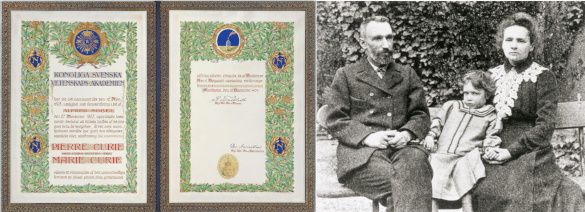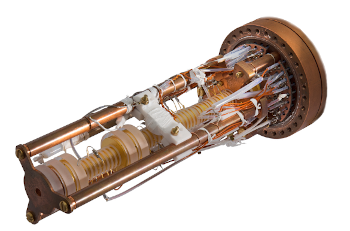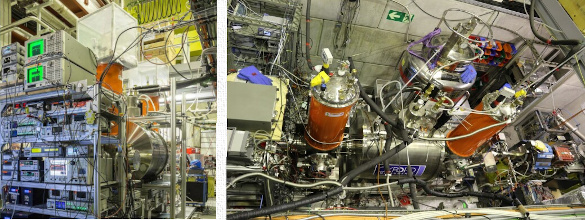Antimatter
March 21, 2022
Antimatter, in the form of an antimatter
electron called a
positron, was
predicted by
Paul Dirac (typically referred to as P.A.M. Dirac, 1902-1984) in 1931. The positron, called an
anti-electron by Dirac, was predicted to have the same
mass and the opposite
charge as an electron, and it had the interesting property that it would
annihilate an electron on contact to produce
energy. One interesting antimatter concept is the
Feynman-Stueckelberg interpretation that antiparticles are actually regular
particles that are traveling backwards in
time. The existence of the positron was confirmed by
experiment quite quickly, by
Carl D. Anderson (1905-1991) in 1932 who observed it in
cloud chamber photographs of
cosmic rays, and it received its
positron name in the
paper announcing the discovery.[1-2]
Being the first to
publish, Anderson won the
Nobel Prize in Physics in 1936, but there was
contemporaneous evidence from other
research groups.
Frédéric Joliot-Curie (1900-1958) and
Irène Joliot-Curie (1897-1956), the elder
daughter of
Pierre Curie (1859-1906) and
Marie Curie (1867-1934), had photographs with evidence of positrons, but they thought they were
protons.
Patrick Blackett (1897-1974) and
Giuseppe Occhialini (1907-1993) of the
Cavendish Laboratory discovered many opposing photographic
spirals of
positron-electron pair production in 1932, but they delayed publication to obtain more
data. This may have been a consequence of the research
philosophy of Cavendish
director,
Ernest Rutherford (1871-1937);[3] or, as they say,"
extraordinary claims require extraordinary evidence."

Nobel Prize diploma for Pierre Curie (1859-1906) and Marie Curie (1867-1934), 1903 (left) and a circa 1902 photograph of them with daughter, Irène Curie (1897-1956). They received the Nobel Prize in Physics "for their joint researches on the radiation phenomena discovered by Professor Henri Becquerel". The prize was shared with Henri Becquerel (1852-1908), the discoverer of spontaneous radioactivity. Their daughter, Irène Joliot-Curie (1897-1956), and her husband, Frédéric Joliot-Curie (1900-1958), were awarded the 1935 Nobel Prize in Chemistry for their discovery of induced radioactivity. (Left, Wikimedia Commons image uploaded and retouched by Jebulon, and right, another Wikimedia Commons image. Click for larger image.)
After the discovery of the positron came the more difficult discovery of the
antiproton by
Emilio Segrè (1905-1989) and
Owen Chamberlain (1920-2006) in 1955, for which they received the 1959 Nobel Prize in Physics. Having positrons, antiprotons, and
antineutrons allows the existence of antimatter equivalents of the
chemical elements, and both
antihydrogen and
antihelium have been observed.
Alchemists weren't successful in
turning lead into gold, but
positron emission is capable of
changing one element into another. Emission of a positron and an
electron neutrino from a
nucleus converts a proton into a
neutron, thereby decreasing the
atomic number; for example,
11C -> 11B + e+ + νe
in which
carbon with an atomic number of 6 is transformed into
boron with an atomic number of 5. Natural positron emission occurs rarely on
Earth, generally induced by a cosmic ray or from a small percentage of
decays of the rare
isotope,
potassium-40. Some other isotopes that exhibit positron decay are
nitrogen-13,
oxygen-15,
yttrium-86,
strontium-83, and
iodine-124. Positrons have proven useful in
medical scans known as
positron emission tomography.
Long before
Star Trek fueled its
warp engines with an annihilation reaction of
antideuterium and
deuterium, moderated by
Dilithium, antimatter had become a topic in
science fiction.[4] Dirac's 1933 Nobel Prize
lecture speculated that
stars other than our
Sun might be composed of antimatter, as would their
planets.[4]
John W. Campbell, Jr., who was
editor of
Astounding Science Fiction magazine, decided that this
idea would make a good science fiction
story, so he recruited a member of his
author cohort,
Jack Williamson (1908-2006), to write such a story. Williamson's story, "
Collision Orbit," was published in the July 1942 issue of Astounding Science Fiction under the
pen name Will Stewart.[4] The story envisions harvesting antimatter using
magnetic fields, and three
sequels were later published.[4]
Antimatter particles have charge and
magnetic moment of equal
magnitude but opposite
sign, and their mass appears to be the same. There has been a continued effort to verify this equality of mass between protons and antiprotons. A huge international team has just determined that the antiproton-to-proton charge/mass
ratio is the same at a 16
parts per trillion level, the implication being that the masses of the proton and antiproton are equal.[5-7] The team has members from
RIKEN (Saitama, Japan), the
Leibniz Universität Hannover (Hannover, Germany),
Physikalisch-Technische Bundesanstalt (Braunschweig, Germany),
CERN (Meyrin, Switzerland), the
Max-Planck-Institut für Kernphysik (Heidelberg, Germany), the
University of Tokyo (Tokyo, Japan),
GSI-Helmholtzzentrum für Schwerionenforschung (Darmstadt, Germany), the Johannes Gutenberg-Universität (Mainz, Germany), and the
Johannes Gutenberg-Universität (Mainz, Germany). Their results were published in a recent issue of
Nature.[5]
This is the latest result from the
Baryon Antibaryon Symmetry Experiment (BASE) at CERN, and the measurement is an improvement of a previous measurement that had a 1.5
parts per billion precision.[5-6] BASE uses antiprotons from CERN's
antimatter factory.[6-7] The result derives from the combination of four independent long-term studies done over a span of 1.5
years, from December 2017 to May 2019.[5,7] These studies used different measurement methods and experimental set-ups, so they had different
systematic errors.[5]
In order to compare protons and antiprotons directly, the experiment uses
negatively charged hydrogen ions as the proton
reference so the negatively charged particles can both be measured in the same device called a
Penning trap.[6-7] The Penning trap uses
magnetic fields and
electric fields to trap the particles in a
cyclotron resonance, and the
frequency of the resonance gives the charge-to-mass ratio.[6-7] The mass difference between the hydrogen ion and a bare proton is known with an uncertainty of 0.03 parts per trillion.[6-7] The experiment obtained more than 24000 cyclotron-frequency comparisons, each lasting 260 seconds.[7]

The Baryon Antibaryon Symmetry Experiment (BASE) Penning trap.
CERN image.
According to the
standard model of
particle physics, matter and antimatter should be
mirror images of each other with regard to
CPT symmetry, and they should have equal mass, equal but opposite charge, and respond equally in magnitude to the
fundamental forces.[6] Any slight difference between the masses of protons and antiprotons, or between the ratios of their electric charge and mass, would violate CPT symmetry and indicate
new physics beyond the standard model.[7] Such a difference might explain why the universe is nearly devoid of antimatter, although equal amounts of antimatter and matter should have been created in the
Big Bang.[7]
Since the experiment was conducted over multiple years, it was possible to test the so-called
weak equivalence principle, which requires matter and antimatter to
fall at the same rate in the same gravitational field.[6-7] Since the Earth has an
elliptical orbit around the
Sun, the
Earth-Sun distance changes and the Sun's
gravitational potential is about 3% stronger in January than in July.[6] The research team could find no variation in the cyclotron frequency ratio between
winter and
summer.[6]

As these views of the Baryon Antibaryon Symmetry Experiment (BASE) show, experimenters need to be electronics experts and plumbers. The experiment is located in the CERN antiproton decelerator. (CERN photographs by Stefan Ulmer, who was an author of the study.)
References:
- Carl D. Anderson, "The Positive Electron," Physical Review, vol.43, no. 6 (March 15, 1933), pp. 491ff., DOI:https://doi.org/10.1103/PhysRev.43.491.
- This Month in Physics History - Discovery of the Positron, August 1932, APS News.
- Richard Reeves, "A Force of Nature: The Frontier Genius of Ernest Rutherford," W. W. Norton & Company, December 17, 2007, 208 pp., ISBN 978-0393057508 (via Amazon).
- William S. Higgins, "Antimatter's science fiction debut, Fermilab Symmetry Magazine, September 1, 2008.
- M. J. Borchert, J. A. Devlin, S. R. Erlewein, M. Fleck, J. A. Harrington, T. Higuchi, B. M. Latacz, F. Voelksen, E. J. Wursten, F. Abbass, M. A. Bohman, A. H. Mooser, D. Popper, M. Wiesinger, C. Will, K. Blaum, Y. Matsuda, C. Ospelkaus, W. Quint, J. Walz, Y. Yamazaki, C. Smorra, and S. Ulmer, "A 16-parts-per-trillion measurement of the antiproton-to-proton charge–mass ratio," Nature, vol. 601, no. 7691 (January 5, 2022), pp. 53-57, https://doi.org/10.1038/s41586-021-04203-w.
- Michael Schirber, "Antiproton Mirrors Proton," Physics, vol. 15, no. 8 (January 19, 2022).
- BASE breaks new ground in matter–antimatter comparisons, CERN News, January 5, 2022
Linked Keywords: Antimatter; electron; positron; prediction in science; predicted; Paul Dirac (typically referred to as P.A.M. Dirac, 1902-1984); mass; electric charge; annihilation; annihilate; energy; Feynman-Stueckelberg interpretation; elementary particle; time; experiment; Carl D. Anderson (1905-1991); cloud chamber; photograph; cosmic rays; scientific literature; paper; publish; Nobel Prize in Physics; contemporaneous; research; Frédéric Joliot-Curie (1900-1958); Irène Joliot-Curie (1897-1956); daughter; Pierre Curie (1859-1906); Marie Curie (1867-1934); proton; Patrick Blackett (1897-1974); Giuseppe Occhialini (1907-1993); Cavendish Laboratory; spiral; positron-electron pair production; data; philosophy; director; Ernest Rutherford (1871-1937); Sagan standard; extraordinary claims require extraordinary evidence; Nobel Prize diploma for Pierre and Marie Curie, 1903; ionizing radiation; Henri Becquerel (1852-1908); spontaneous fission; spontaneous radioactivity; Nobel Prize in Chemistry; induced radioactivity; Wikimedia Commons; Jebulon; antiproton; Emilio Segrè (1905-1989); Owen Chamberlain (1920-2006); antineutron; chemical element; antihydrogen; antihelium; Alchemist; Chrysopoeia; turning lead into gold; positron emission; nuclear transmutation; changing one element into another; electron neutrino; atomic nucleus; neutron; atomic number; carbon; boron; Earth; radioactive decay; isotope; potassium-40; nitrogen-13; oxygen-15; yttrium-86; strontium-83; iodine-124; medicine; medical; positron emission tomography; Star Trek; fuel; warp drive; warp engine; antideuterium; deuterium; Dilithium (Star Trek); science fiction; lecture; speculative reason; speculate; star; Sun; planet; John W. Campbell, Jr.; editor-in-chief; Analog Science Fiction and Fact; Astounding Science Fiction magazine; idea; narrative; story; author; cohort; Jack Williamson (1908-2006); Collision Orbit; pen name; sequel; magnetic moment; Euclidean vector; magnitude; sign (mathematics); ratio; parts-per notation; parts per trillion; RIKEN (Saitama, Japan); Leibniz Universität Hannover (Hannover, Germany); Physikalisch-Technische Bundesanstalt (Braunschweig, Germany); CERN (Meyrin, Switzerland); Max-Planck-Institut für Kernphysik (Heidelberg, Germany); University of Tokyo (Tokyo, Japan); GSI-Helmholtzzentrum für Schwerionenforschung (Darmstadt, Germany); Johannes Gutenberg-Universität (Mainz, Germany); Nature (journal); Baryon Antibaryon Symmetry Experiment (BASE); parts per billion; accuracy and precision; antimatter factory; year; systematic error; electrical polarity; negative charge; hydrogen ion; standard (metrology); reference; Penning trap; magnetic field; electric field; cyclotron resonance; frequency; standard model; particle physics; parity (physics); mirror image; CPT symmetry; fundamental interaction; fundamental forces; new physics beyond the standard model; Big Bang; weak equivalence principle; gravitational acceleration; fall at the same rate in the same gravitational field; elliptical orbit; Sun; Earth's orbit; Earth-Sun distance; gravitational potential; winter; summer; experiment; experimenter; electronics; expert; plumber; CERN antiproton decelerator; Stefan Ulmer.